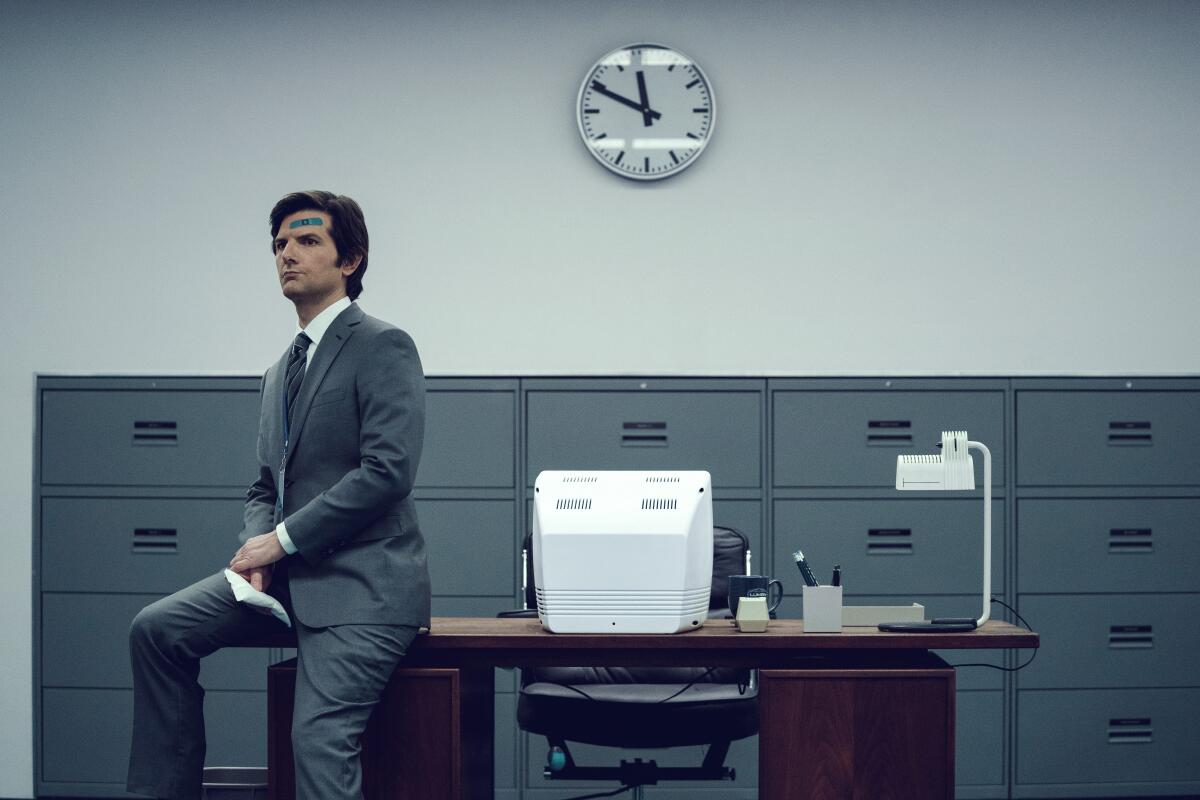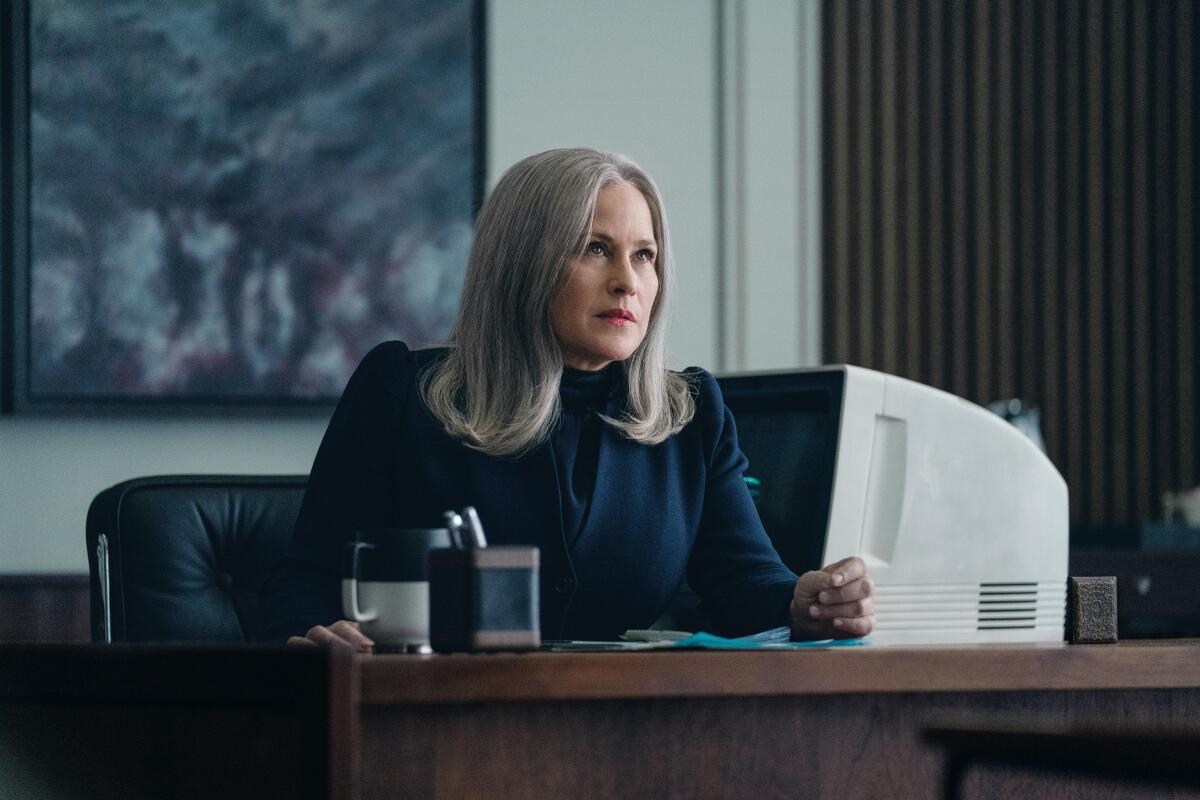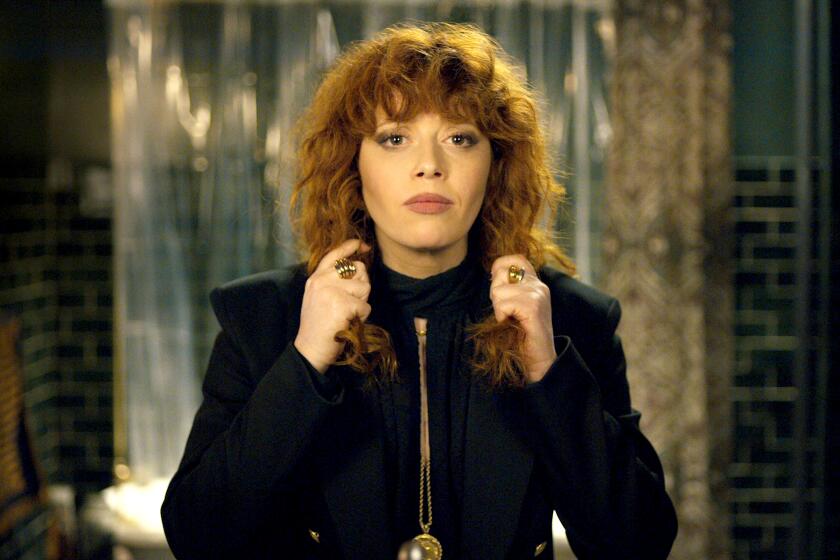A new TV show tackles the problem of work-life balance. But its solution disappoints

- Share via
“Severance,” which begins Friday on Apple TV+, is a vexing near-future science-fiction mystery with overtones of a corporate conspiracy thriller.
Created by Dan Erickson, directed by Ben Stiller and Aoife McArdle, it shares narrative or aesthetic notions with works as diverse as “Eternal Sunshine of the Spotless Mind,” “Office Space,” “Awake” (in which a detective awakens to a different life when he goes to sleep in another) and “Counterpart” (the dual-reality J.K. Simmons spy show), with maybe a little “Alphaville” mixed in.
Adam Scott plays Mark, who works for a company called Lumon, whose purpose is no more clear than the work he does there. The impossible gimmick at the heart of the series is a procedure called “severance,” by which one’s workplace consciousness is surgically divided from the rest of one’s life, and vice versa. When Mark steps off the elevator on “the severed floor” at the start of the workday, he forgets who he is outside; when he steps off the elevator at the end of the day, he forgets what he does, and whom he knows, at work. The fictional mechanics of this are fairly well worked out, and well explained, with additional technologies written in to keep the “Innies,” as the work-conscious workers are called, from communicating with the “Outies,” as their other, one would say original, selves are called.
Mark’s co-workers are the ideologically invested Irving (John Turturro), the practical, cynical Dylan (Zach Cherry) and newcomer Helly (Britt Lower), replacing the suddenly missing Petey (Yul Vazquez, when we see him), whose absence moves Mark into a supervisory position. Their semi-cubicle workstations are arranged in a pinwheel formation in the middle of a large, otherwise empty room, devoid of decoration.
The complete guide to home viewing
Get Screen Gab for everything about the TV shows and streaming movies everyone’s talking about.
You may occasionally receive promotional content from the Los Angeles Times.
They are engaged in something called “macrodata refinement,” a bit of nonsense that involves roping off groups of numbers on a screen and placing them in a box. (Expertise is gained by intuition.) A sufficient percentage of “correct” results earns the prizes, from a finger trap puzzle to the sort of caricature you might have drawn at an amusement park, to the big prize, a “Waffle Party.”
It might as well be called the Maguffin Corporation, given that whatever their work might be revealed to affect, if indeed it affects anything at all, will be less important than the fact that none of them have any idea what it’s about and less interesting than the pokily building adventure that gets them to wherever this show is meant to end. Clues are dropped that something deeper is going on, but so much time elapses between them that you may have dropped one by the time you gather the next.
Awkwardly overlaid on this, like a sequined cape over a khaki jumpsuit, is a cult element, centered on Lumon founder Kier Eagan, whose head is carved, Soviet-style, on a giant bas relief overlooking the Lumon atrium, and incidents from whose life are represented in 19th century mock heroic metaphorical paintings that turn up here and there around the place. The company, we are told, has been in business since 1866, doing whatever it does. “Actively caring for mankind,” is Irving’s thought, but he has no idea.
“Mark, at this time I confer upon you the freedom to serve Kier in the advanced role of Macrodata Refinement department chief. A handshake is available on request,” is how Mark receives his promotion from his boss, Harmony (Patricia Arquette).

Although there are establishing shots in the first episode of a full parking lot and a lot of extras gliding through the lobby, our heroes on their special floor have little contact with anyone outside of Harmony’s quietly, creepily enthusiastic factotum, Mr. Milchick (Tramell Tilman). (“Severance” has the empty quality of having been produced during a pandemic.) Eventually we will meet Christopher Walken as Burt, head of Optics and Design, which hangs those paintings and creates the “handbook tote bags,” a sort of joke, since handbooks can’t be taken anywhere. (There are also some awful-looking talking statues in the shrine-like Perpetuity Wing, adding banality to banality.) So discrete are the departments that weird rumors float in each about the other, put about by management perhaps to keep them separate.
The question does return throughout the series: What exactly are we watching? As a critique of office life, it’s empty, and somewhat patronizing. To be sure there are all kinds of toxic workplaces and bad jobs and absurd institutional protocols, but many people like their work and find community there. (Scott’s other series, “Parks & and Recreation” and “Party Down,” are better on the subject.) Or is it just a thriller with exotic trimmings in an unusual setting?
There is certainly a strain of comedy being worked here, along with some seemingly random, one might say Buñuelian weirdnesses, but it is not often funny; at times, it feels meant as satire, but of what? “Severance” isn’t without ideas — possibly, too many for any to take hold. Some might be better termed effects, as in the first shot of the series: Helly seen from above, lying on a conference table, like a murder victim or sacrifice. It’s visually striking, possibly metaphorical, although why she is lying on a conference table and not, say, on a couch, or seated in a comfortable chair, seems predicated more on the aesthetic than the sensible. More than a few things of that sort occur here.
Although it gives a good conceptual footing for Erickson’s split-brain mystery, the whole severance thing doesn’t bear much inspection. As a security system it seems pointless; Mark and his co-workers have no idea what they’re doing anyway, and see nothing that would make any sense outside their room. (It barely does inside.) There is no benefit for the Innies, who, as the series is careful to note, would never have the sensation of sleep, breathing fresh air, seeing the light, or being anywhere but work, occasional breaks for a “party” notwithstanding. Only the new girl seems to feel the lack.
For the record:
8:26 p.m. Feb. 17, 2022An earlier version of this article mischaracterized the macrodata refiners in “Severance.” Three are white, not all of them.
“First, imagine yourself on a seesaw,” Mark tells Helly during her orientation, bringing up the “work-life balance”; the extreme expression of this idea would seem to be the inspirational spark for the whole series. But of course it isn’t balance. It’s just a seesaw with one person on it. That it amounts to slavery — trapping someone in a life of labor to make your life easier, even if it’s “you” — is danced around but remains unspoken. (This may be because three of the macrodata refiners are white, and fair enough, if so.)
We surveyed The Times TV team to come up with a list of the 75 best TV shows you can watch on Netflix. As in, tonight.
Outie Mark may claim he benefits from the arrangement, but he has no idea whether his Innie is happy there and gains no satisfaction from his life outside. He has no friends; consumed by grief over the death of his wife, he drinks too much, too often. (It is noted that he brings his sadness to work, even if he doesn’t know what it is.) He has a nice, normal sister (Jen Tullock), whose every appearance, unmarred by Lumon drama, is a relief. She’s married to Rickon (Michael Chernus), an author of inspirational books, with titles like “The You You Are: A Spiritual Autobiography of You,” that are mostly but not entirely ridiculous and will play a triggering role in the drama.
The performers, including the always welcome Dichen Lachman as Mrs. Casey, a sort of therapist, are excellent. Scott, whose casting may or may not have something to do with his Ben Wyatt on “Parks and Recreation,” plays off and against his baseline regular guy neediness/nerdiness; we get him here atypically worn out, less than confident. Turturro and Walken, whose characters are emotionally paired, do delicate work together. (It is always pleasant to remember that Walken is an actor, not merely a Christopher Walken imitation.) As Helly, Lower has an almost brutal energy. Arquette, who wears more than one face in the drama, takes the sleepy quality that has served her well through the years, and adds a drop of acid.
Appropriately for a show about limited consciousness, “Severance” benefits from your paying attention to whatever is happening in front of you at the moment, a performance, an exchange, the cinematography, some carefully crafted bit of Lumon ephemera, how cold it looks in the Hudson Valley and Holmdel, N.J.— where Eero Saarinen’s 1962 Bell Labs building serves as Lumon headquarters — without worrying too much about how the whole thing might knit together. (The series is set in some nameless northeastern somewhere.) The nearly unbroken whiteness of the workplace is echoed by the snow-covered landscapes outside. In or out, Innie or Outie, it’s not a colorful world these characters inhabit.
And because there is a mystery, if only in the sense that we are given very little information — even the characters, apart from Mark, have been severed from their backstories — one keeps watching, to discover what’s being held back, however many trips down a white corridor to jaunty tropical hold music that entails. You will have to wait a little; the season finale is genuinely exciting and suspenseful, but, really, even as an advocate of slow television, we might have got there in half the time with twice the effect. Rod Serling could have wrapped it up in half an hour.
More to Read
The complete guide to home viewing
Get Screen Gab for everything about the TV shows and streaming movies everyone’s talking about.
You may occasionally receive promotional content from the Los Angeles Times.








